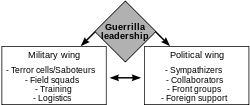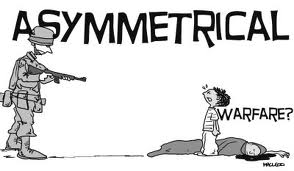

It may require only small groups of highly mobile guerrillas to defeat the state's military forces if the population remains apathetic. The main political strategy of guerrilla warfare is to win positive control over successively larger portions of the civilian population while simultaneously alienating the population from the regime in power. Although every country poses different strategic and tactical problems arising from varied political, social, economic, and geographic conditions, most of the major postwar guerrilla uprisings have displayed some common characteristics. They usually begin with a small handful of dedicated men who make no pretense of having a popular base or political legitimacy, but nevertheless organize themselves into small military-political units to launch attacks against established authorities at the village level. Nor do they necessarily infiltrate voluntary organizations, organize mass demonstrations, run parliamentary candidates, or seek ministerial positions. Guerrilla units, for example, do not wait for a "revolutionary situation" to develop before they begin direct assaults on the state and society. 3.Ĭlandestine Actions and Military Intervention 2 (Spring 1974), 127-56 Time, Septemand the New York Times, September 9, 1974, p. Sigmund, "Less Than Charged," in Foreign Policy, No. Role? More Than Admitted," and the rebuttal of her arguments by Paul E. Because of the different environmental and historical traditions, subversion as practiced in Europe and unconventional warfare as practiced in Asia and Cuba have been basically different means of gaining power.Ģ7 The facts of the Chilean episode come from Elizabeth Farnsworth, "Chile: What Was the U.S. Unlike their Western comrades, who were concerned primarily with subversion and infiltration in an urban setting, the Chinese and Cubans engaged in protracted rural guerrilla warfare before achieving power. The romantic and ideological inspiration for guerrilla operations originated with Mao Tse-tung and the Chinese Communists and was refined by Che Guevara. This area offers particularly attractive conditions for guerrilla operations, including dense jungles and marshes in which troops can hide, a predominantly rural population often cut off from direct influence from the central government, undeveloped communication facilities between villages and urban centers, and long, unprotected frontiers that permit easy infiltration and supply of materiel from the "active sanctuary" (the country promoting the unconventional warfare). In Southeast Asia, however, Noth Vietnam and Communist China played major roles in organizing, training, and supporting "national liberation" movements operating in Malaya, South Vietnam, Laos, Cambodia, Thailand, and Malaysia. Successful guerrilla campaigns in Cyprus, China, and Cuba were basically internal rebellions, conducted with a minimum of external interference.

Some of the longest and most tragic unconventional military operations have been purely domestic affairs, as in Colombia, where internal strife with characteristics of guerrilla warfare has killed several hundred thousand people over the last thirty years.

Of course, not all guerrilla operations have been organized, supported, or directed by an outside power. This type of revolutionary activity, which combines terror with mobile guerrilla attacks, was used extensively in Yugoslavia and other occupied countries during World War II and has since occurred in more than fifteen countries. As the focus of the cold war shifted from Europe to Asia, Africa, and Latin America, guerrilla warfare supplanted some of the conventional techniques of subversion discussed above.


 0 kommentar(er)
0 kommentar(er)
